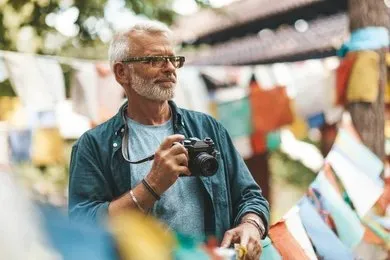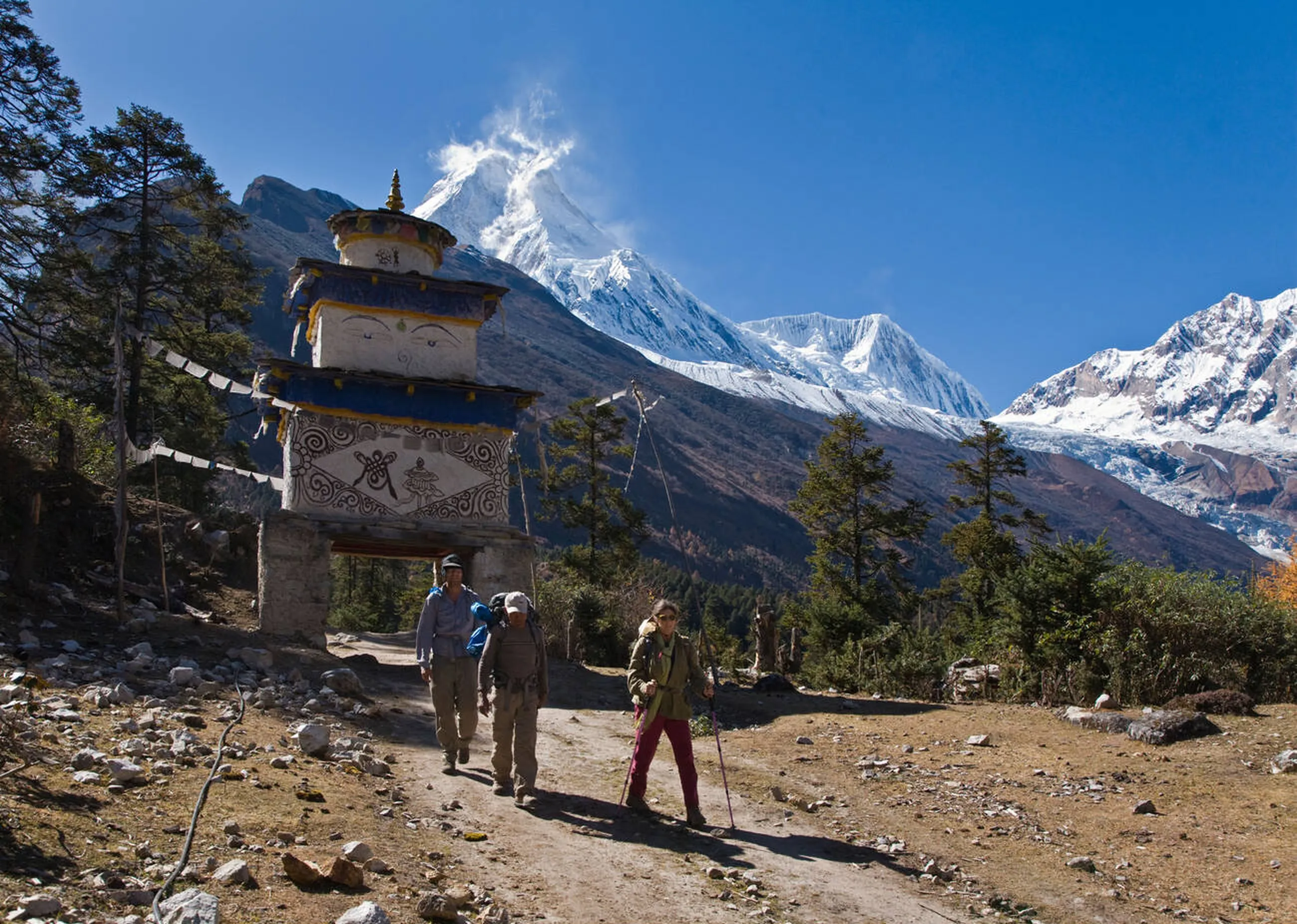Nepal vision | 04/08/2025
Trekking through the trails of the Himalayas, passing by the prayer flag fluttering, clouds beneath the feet, waving to the exotic animals, and learning about the new cultures of people living in the Himalayas region. But you want to experience the adventure, but you take time to think, maybe the ship has sailed.
We're here to tell you it hasn’t.
Some of the most inspiring people you’ll meet on the trail aren’t twenty-something adrenaline junkies but folks in their 50s, 60s, even 70s who decided they weren’t done chasing horizons. They’re out there, walking beside yaks, sipping tea in remote mountain villages, and proving something powerful to themselves with every step.
The truth is, simple trekking in the Himalayas is for anyone curious enough to go. What you need is the willingness to take it slow, listen to your body, and trust that a bit of preparation goes a long way.
In this piece, we will talk all about the older traveller conquering the Himalayas. Everything you need to cover, from the right trail to training smart to hearing from people who’ve done it and come back with a fire in their eyes.
And if part of you is thinking maybe… just maybe… you’ve got one big adventure left in you, then keep reading.
Because you do.
Why Are More People Over 50 Trekking the Himalayas?
More and more travelers over 50 are taking on the challenge of trekking in the Himalayas, and it’s not hard to see why.
For one, there’s a growing focus on health and fitness among older adults. Many people in their 50s and 60s are staying active through walking, yoga, hiking, or gym workouts. With stronger joints, better stamina, and a greater awareness of how to care for their bodies, they feel more physically ready to take on a trek.
Alongside that, retirement often brings the freedom to finally do the things that work schedules and family commitments once pushed aside. With fewer time constraints and more savings set aside for meaningful experiences, trekking becomes less of a dream and more of a plan.
There’s also the influence of the media. Over the past decade, travel blogs, YouTube channels, and documentaries have highlighted older trekkers taking on the Himalayas with determination and joy. Seeing someone their age on a high-altitude trail can be the spark that pushes others to give it a try.
In addition, trekking has become more accessible. The quality of gear has improved; boots are lighter, backpacks are more supportive, and layered clothing helps regulate body temperature in changing conditions. Guided treks now cater to all fitness levels, offering well-paced itineraries, rest days, and reliable support staff.
Taken together, these factors are changing the narrative. Trekking is no longer just for the young and restless. It’s for anyone ready to take the next step, no matter their age.

Is Trekking After 50 Realistic?
Trekking after 50 is not only realistic but becoming more common across major trekking destinations like Nepal.
Many older adults maintain or build stamina through regular walking, light strength training, and proper nutrition, which helps them prepare for multi-day hikes.
While the body’s ability to adapt to altitude slows with age, gradual ascents, well-planned itineraries, and acclimatization days help prevent altitude sickness.
Recovery also takes longer, so it’s essential to stay hydrated, eat protein-rich meals, and get quality sleep. Trekking poles, lighter gear, and guided support further reduce physical strain. In Nepal, about 27% of foreign trekkers fall within the 46–60 age group, and an increasing number are over 60.
An 81-year-old successfully reached Everest Base Camp in 2023, showing that age alone is not a limitation with preparation, pacing, and the right mindset; older trekkers continue to thrive on the trail.
Choosing the Right Trek: Top Himalayan Trails for 50+ Trekkers
Choosing the right trek in the Himalayas after age 50 means finding a trail that fits your fitness level, comfort with altitude, and interests in scenery and culture. The good news is that the Himalayas offer many routes suitable for older travellers, from easy, short hikes to longer, more cultural journeys. So why wait?
Easy to Moderate Treks (Short duration, low to moderate altitude):
- Ghorepani Poon Hill (4–5 days, max 3,210m) — gentle climbs, stunning Annapurna views, village stops
- Langtang Valley (7–8 days, 3,870m max) — gradual ascent, rural culture, cheese factory visit
- Pikey Peak (6–7 days, 4,065m max) — panoramic Everest views, less crowded Sherpa villages
- Everest View Trek (5–8 days) — Everest panoramas, easier than Base Camp trek
Moderate to Challenging Longer Treks (Include acclimatization days):
- Annapurna Base Camp (7–12 days) — varied scenery, steady altitude gain, hot springs
- Manaslu Circuit (12–15+ days) — remote, requires acclimatization, Buddhist culture
- Upper Mustang (10–16 days) — Tibetan heritage, dry climate, unique landscapes
- Tsum Valley (14+ days) — Buddhist monasteries, remote villages, gradual elevation gain
Altitude Sensitivity:
- Choose treks below 4,000m or with gradual altitude gain if concerned about AMS (acute mountain sickness).
- Ghorepani Poon Hill, Dhampus/Sarangkot, and the Tamang Heritage Trail are low-altitude, making them suitable for beginners.
- Langtang Valley and Everest View treks have slow altitude gain and frequent tea houses for acclimatization.

Pre-Trek Preparation: Fitness & Mindset for 50+ Trekkers
Preparing for a Himalayan trek after 50 means focusing carefully on both your body and mind. Because trekking at high altitude can be demanding, it’s important to train properly, take care of your health, and set the right mental attitude. Below, you’ll find easy-to-follow advice to help you get ready and enjoy your trek safely and confidently.
Training Plan for 50+ Trekkers
To begin with, building endurance and strength is key. Regular walking and hikes will help your body get used to long days on the trail. In addition, including simple strength exercises will support your joints and muscles. Don't forget to stretch and practice balance moves to reduce the risk of falls. Finally, training with your trekking poles and backpack will prepare you for real conditions and make the trek easier.
Medical & Health Prep
Next, health checks are essential before your trek. Make sure to see your doctor for a complete checkup and discuss your trekking plans, especially if you have any chronic conditions. Carry your medications and keep your health monitored during the trek. Also, travel insurance that covers emergencies and evacuations is a must. If needed, ask your doctor about medicines to prevent altitude sickness.
Mental Preparation
Lastly, preparing mentally is just as important. Feeling nervous before a big trek is usual, so accept those feelings and focus on your progress. Take your time on the trail, listen to your body, and remember that success is about enjoying the journey safely. Many older trekkers find that the best parts of trekking are the memories and challenges along the way, not just reaching the top.
Altitude Acclimatization and Safety
When you climb above 2,500 m, your body needs time to adjust because the air has less oxygen. Without enough rest, you risk developing altitude sickness, also called Acute Mountain Sickness (AMS).
Symptoms of AMS include headache, nausea, dizziness, fatigue, and trouble sleeping. To prevent this, it’s crucial to include rest days in your trek, especially after crossing 2,500 meters, so your body can acclimatize properly.
In addition to resting, some trekkers use medicines like Diamox to reduce symptoms by improving how their body handles lower oxygen levels. However, you should always consult your doctor before taking any medication to ensure it’s safe for your health.

Trekking Smarter, Not Harder: Tips for Older Hikers
- Use porters or pack animals to reduce physical strain
- Hire experienced guides for safety and support
- Choose lodges instead of tents to improve comfort and aid recovery
- Maintain proper hydration and nutrition, especially at altitude
- Prioritize good sleep and allow time for recovery
To wrap up, age is not a barrier; it’s your greatest strength when it comes to trekking in the Himalayas. With thoughtful planning, proper training, and the right mindset, you can turn this adventure into one of the most rewarding experiences of your life.
Remember, every step you take is a testament to your resilience and spirit. So don’t wait, embrace this journey with confidence and excitement.
When you’re ready to take the next step, Nepal Vision Treks is here to guide you with expert advice and customized itineraries designed especially for trekkers over 50. Start planning your Himalayan adventure today and prove that the best chapters are still ahead.
FAQS









